Aquaculture in Galicia: a review of the past 25 years and prospects for the next 25Agricultural
Jacobo Fernández Casal
Graduate in Biological Science Member of the Galician Estuaries Marine Resources and Aquaculture Forum Association (Asociación Foro Recursos Marinos y Acuicultura de las Rías Gallegas)
O Grove,
Pontevedra - Spain
Aquaculture is not a novelty in Galicia. Over the past 25 years it has brought wealth to the region, particularly with the development of turbot rearing. Galicia is destined to play a major role in flatfish farming thanks to its exceptionally favourable conditions, location, rolling topography and moderate temperatures. But in order to continue as industry leader, it must maximise these advantages while -as everpaying due regard to social and environmental standards
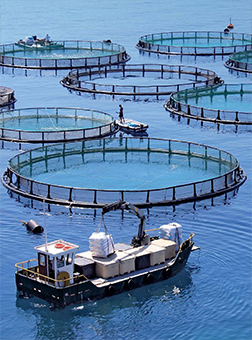
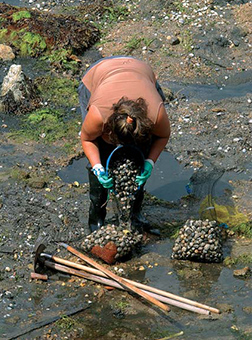
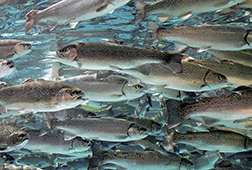



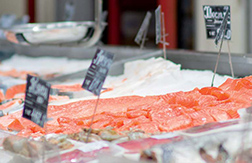

The origins of aquaculture go back to 3500 BC in China and 2500 BC in Egypt. The oldest known treatise on the subject, which deals with carp breeding, was written by the Chinese politician Fan-Li in 475 BC. In Europe, the first experiences were carried out 2000 years ago in the time of the Roman Empire, where oyster farming was widespread. The Romans grew oysters in marshlands, where they also extracted sea salt and dry-salted fish. In the 14th century, trout culture saw a large expansion in France. Salmonid breeding soon became an important activity in the Nordic countries. Trout were first farmed in 1910 in Norway, where the species was adapted to sea water. By 1950 modern fish rearing had been successfully introduced to the freezing waters of the fjords. The first precise reference to fish farming in Spain dates from the 12th century, when Diego Xelmírez, who was archbishop of Santiago de Compostela in Galicia at that time, ordered the construction of a trout farm in the river Sar (A Coruña province). But it was not until 1866 that the first private fish farm was built in the Stone Monastery in Zaragoza, in the region of Aragón. A few years later, in 1886, the Experimental Zoology and Botany Maritime Station was established in Santander, which eventually evolved into today’s Spanish Oceanography Institute. Spain’s entry into the European Union in 1986 was a further landmark. Aquaculture expanded rapidly from that year, producing large yields of fish and molluscs.
The first precise reference to fish farming in Spain dates from 1129, when Diego Xelmírez, who was archbishop of Santiago de Compostela in Galicia at that time, ordered the construction of a trout farm in the river Sar (A Coruña province)
Aquaculture and research in Galicia
The Practical School of Oyster Farming was founded in Galicia in 1847 in the town of Ortigueira, in Coruña province. The first mussel breeding experiences got under way in 1928, but it was not until 1945 that raft farming was introduced. Modern trout culture in Galicia began in 1968, later to be followed by salmon culture. The first successful mollusc farms in Galicia started operating in 1970, producing oysters and clams. In 1983, industrial farming of turbot began in O Grove (Pontevedra province, Galicia).
Yet none of this would have been possible without research, which has provided the support needed to achieve today’s standards of production and recognition in the productive system. Santiago University’s Microbiology Department is well known for its accomplishments in producing vaccines against diseases in turbot. The universities of Vigo and A Coruña also provide considerable support to farmers throughout the different stages of the culture process. More recently, the Galician Aquaculture Technology Centre (CETGA, Centro Tecnológico Gallego de Acuicultura) or Galician Aquaculture Cluster was established in 2001 with the clear aim of focusing research primarily on turbot.
According to APROMAR’s1 2012 report on Sea Farming in Spain, in 2011 Galicia was home to 5 hatcheries, 17 grow-out farms (16 landbased and 1 sea-based) and 3 nurseries.
Trout, the oldest farmed species
Trout rearing is the oldest type of aquaculture in Galicia. The first reference dates from 1129, when a trout farm was built on the river Sar (A Coruña province) at the initiative of Archbishop Xelmírez. The first industrial trout farm in Spain commenced operations in 1940. The number of farms grew in the 1960s and 70s. Most of them appeared in northern Spain, chiefly in Galicia, originally as family undertakings with small productions. Farmers’ interest focused on rainbow trout (Oncorhynchus mykiss) on account of its easy adaptation to intensive farming.
The oldest known treatise on the subject, which deals with carp breeding, was written by the Chinese politician Fan-Li in 475 BC
In the 1980s, farms grew in size and production levels. The real breakthrough, however, came in the 1990s with the introduction of improved technologies (use of oxygen and development of vaccines against the main diseases) and marketing processes, which opened the way to trade in new areas. Towards the end of the decade Galicia’s trout production amounted to 8,200 tonnes, namely 27% of Spain’s total production. In 1994, a further landmark was the establishment of a hatchery in Lugo that provided year-round egg availability. This untethered production, which had previously been limited to a few months in the year. The current production of 250 million eggs a year guarantees continuous supply not just to its owners but to a large part of Spain’s fish farms and some overseas clients.
Since 2003, production levels have decreased significantly as a result of falling exports and saturation in the Spanish market. This has been attended by a reduction in production from 9,207 tonnes in 2003 to 6,621 tonnes in 2007 and the close-down of some farms. There are currently 20 rearers in Galicia, operating a total of 25 production establishments, three of them dedicated exclusively to hatching or nursing and the rest to grow-out. The trout farming industry has undergone far-reaching renovation over the last few years to adapt to new market requirements. Still, its future depends on how effectively it can deploy innovation and new brands and quality certification schemes to create value. In 2011, the production of rainbow trout in Spain (see Figure 1) amounted to 19,500 tonnes.
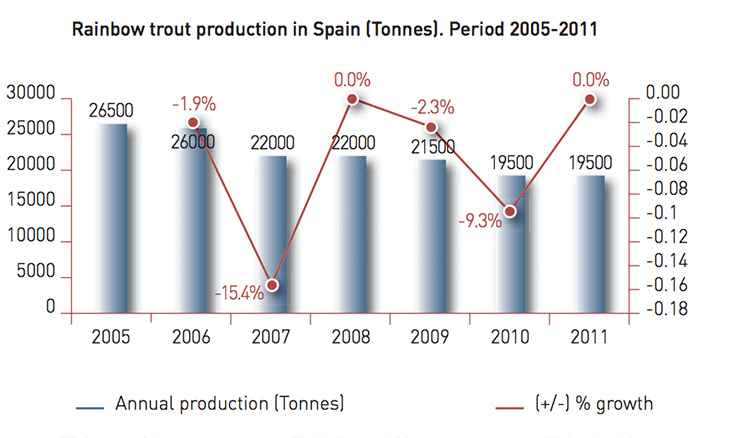
Turbot, a living story
Although turbot farming took its first steps in the early 20th century, it was not until 1968 that Alan Jones first attained larvae metamorphosis after 68 days of nursing.
Turbot (Scophthalmus maximus) culture in Galicia is a living story that goes back to 1983, when Insuiña, the first industrial turbot farming company in Spain, was set up by three entrepreneurs in O Grove. There was certainly no flying start, as everything had to be built up from scratch. But despite all the impediments, the first production of turbot was sold in 1985 at a rewarding 15 euros per kilogram.
In 1992, more than 1,000 tonnes of turbot were released on the market, at a time when a commercial structure had yet to become firmly established. The outcome was an annus horribilis for the industry
In an attempt to stave off an already looming crisis, the Mar Novo Galician Turbot Cooperative was created in 1989, centralising all marketing activities and the procurement of fry and other supplies. The bid proved nevertheless insufficient. In 1992, more than 1,000 tonnes of turbot were released on the market, at a time when a commercial structure had yet to become firmly established. The outcome was an annus horribilis for the industry. While production costs in 1991 were in excess of 7.50 euros, the average sale price that year peaked at 5.42 euros per kilogram. Company losses could not be averted and a restructuring of the industry ensued.
Over the last few years (see Figure 2) production has gradually increased, albeit with some dips caused by health-related problems and fry shortages.
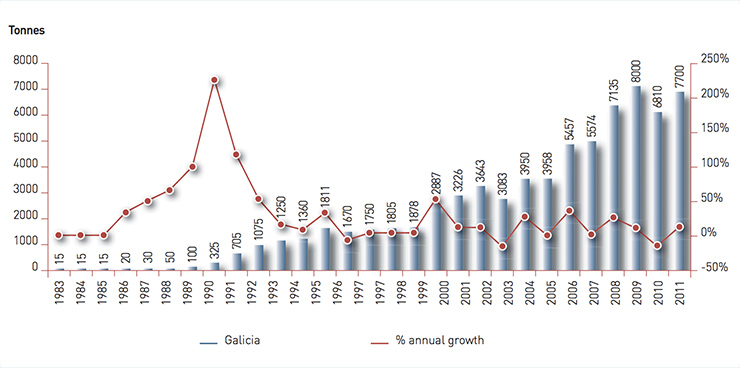
In 2011, farmed turbot production reached 7,755 tonnes (12.2% more than in 2010) according to APROMAR’s 2012 Aquaculture in Spain report. Galicia, with 7,690 tonnes, is by far the largest turbot producer among the Spanish regions.
Globally (see Figure 3), turbot production is concentrated primarily in Europe, with Spain and specifically Galicia as the leading producers.
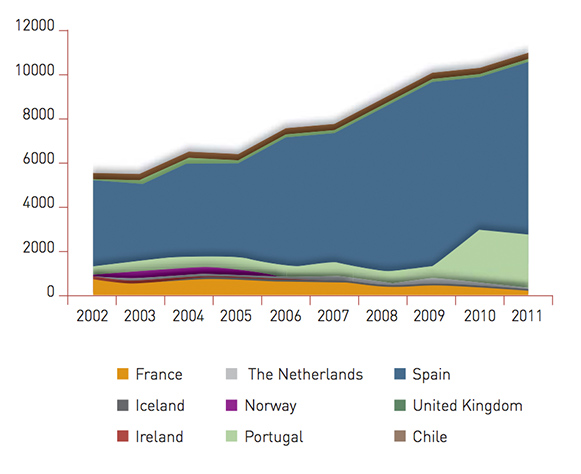
There are currently some twenty flatfish rearing farms and 5 nurseries in Galicia, which produced 7.5 million units in 2007, ensuring the region’s self-sufficiency. According to APROMAR, in 2011 the production of fry reached 17,127,000 units, up by almost 27% from 2010.
Milestones in turbot farming

Challenges facing turbot farming in the next 25 years
Paradoxically, the challenges turbot farming will have to face in the next 25 years are the same as 25 years ago, with a few more added:
- Diseases: significant progress has been achieved but some problems (e.g. furunculosis) are still to be resolved.
- Nutrition: a higher standard of research on fish meal substitutes is needed to keep aquaculture sustainable. As for business challenges, new scenarios are expected in product offer, as well as the opening up of new markets.
- Genetics: progress in genetic improvement is essential.
- Environmental management: after more than 25 years of peaceful coexistence with the environment, it is crucial to undertake further detailed studies of coastal water behaviour in order to prevent potential dysfunctions.
- Government: further to an Aquaculture Programme -which is urgently needed for the industry to remain competitive the key industry players, both public and private, must take educational action to ensure that farming can be carried on normally. Additionally, government support is still vital where legislation, advertising, marketing and finance are concerned.
Turbot farming
The turbot’s rearing cycle begins in a hatchery, where the breeding specimens are housed. From the third year, the breeders start laying gametes, which are carefully fertilised. Then, the resulting spherical, pelagic eggs are incubated for 4–5 days at a controlled temperature. Once hatched, turbot larvae are over 2.7 mm long. They are fed daily with live food: rotifera, artemia and phytoplancton. The ideal temperature for larvae nursing is 18 to 20 ºC.
The fry are kept in square -or round- shaped tanks (10 to 30 m2) with an open-circuit sea water pumping system. Oxygen is often added to the tanks.The fry are fed manually or automatically with balanced dry feed. This stage of the rearing process, known as nursing, spans the fish’s development from 10 to 100 g and lasts for approximately 5 months. Juvenile turbot are also reared in land-based tanks measuring 30 to 100 m2. Again, an open-circuit sea water system is used, although some experience with closed-circuit systems has been gained.
They are fed with extruded pellets, which are distributed manually or automatically. Water temperature is the key factor for optimal development. The ideal growth temperature is 14 to 18 ºC, although turbot will stand extreme temperatures of 8 to 24 ºC. The rearing period until the fish are ready to go to market, with an average weight of 1.8 kg, is 18 to 24 months.

Farming experiences with other species
Salmon: rearing discontinued
Salmon was first farmed in Galicia in 1976 in the Ortigueira estuary in A Coruña province by using traditional cages. Initially, only Atlantic salmon (Salmo salar) was reared. Later, Coho Pacific salmon (Oncorhinchus kisutch) was introduced. From the late 1980s, Atlantic salmon culture developed rapidly in Galicia. It was at that time that round polyethylene cages started to be deployed, similar to the models being used in Norway. Since 2005, there have been no salmon farms in Galicia for a number of reasons, including diseases, production surges in other countries and inadequacies in farm locations. In the first years of this decade, some experimental batches were reared in Galicia’s southern estuaries (Rías Baixas), albeit with uncertain results.

Sea bream: size issues
The first sea bream (Pagellus bogaraveo) rearing experiences in Galicia were conducted in 1991 at Vigo’s Oceanography Centre (IEO2). A stock of breeders was formed with wild specimens captured in their natural environment. The first tonnes of farmed sea bream were marketed in 2002. Production volumes grew year by year and in 2007 the total output reached 195 tonnes. A variety of hurdles have been overcome, including obtaining eggs in captivity and improving survival rates and larvae quality, but the considerable time this species takes to reach its marketable size -3 to 4 years- still constrains production growth. According to APROMAR, Galicia produced 200 tonnes of sea bream in 2011, an amount similar to the previous year’s, which represents 100% of Spain’s production.

Sole: a hopeful future
Most experiences with this species have been carried out by using Senegalese sole (Solea senegalensis), although some studies are currently being conducted with common sole (Solea solea). In 2005, a corporate group marketed the first 8 tonnes of sole farmed in Galicia. Production rose to 30.2 tonnes in 2006 and to 40.3 tonnes in 2007. According to APROMAR, in 2011 the yield reached 79 tonnes (down from 170 tonnes in 2010). Yet there are many aspects still to be developed before production can increase significantly, above all obtaining eggs from specimens held in captivity and controlling disease. The research conducted on common sole has produced encouraging results which may serve as a starting point for the industrial development of the species.

Pollack and gilt head sea bream
The first experiences rearing pollack (Pollachius pollachius) were conducted in the late 1990s. In 2003, eggs were obtained and the first fry produced, which were later grown out in cages. The first marketable yield of this species was produced in 2005 and amounted to 0.15 tonnes. The output reached 39.6 tonnes in 2007. No farms have reared pollack since 2008. Experiences have also been carried out in Galicia to assess the prospects of farming gilt-head sea bream. Wild specimens were reared in tanks between 1989 and 1991 but the growth results were considerably lower than those obtained in other regions. Consequently, the rearing of this species was discontinued in Galicia.
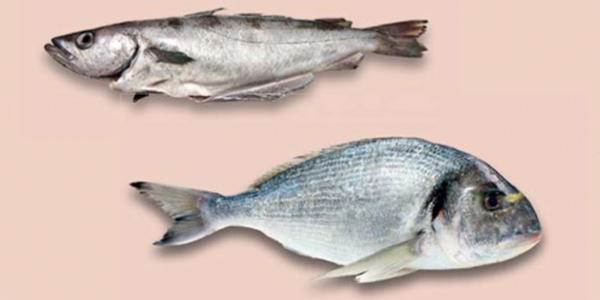
Challenges facing aquaculture in Galicia
Globally, turbot production is concentrated primarily in Europe, with Spain and specifically Galicia as the leading producers
What will happen henceforth? What future lies ahead for Galician fish farming? What size will the companies have? Will they diversify the species they grow? Continental fish farming has reached its maturity and is not going through one of its finest hours at the moment. Still, growers are managing to keep costs in check and so maintain production levels.
Sea fish farming, and particularly turbot rearing, is in a different stage of its development. According to the FAO’s recommendations on the needs of the sea’s food store, stepping up production seems the right way to go. The limits should be set by consumption, demand and production cost margins, as well as social and environmental considerations. A look at the official fish production figures for Europe (Figure 4) reveals that turbot production is far below the industrial production of other fish species.
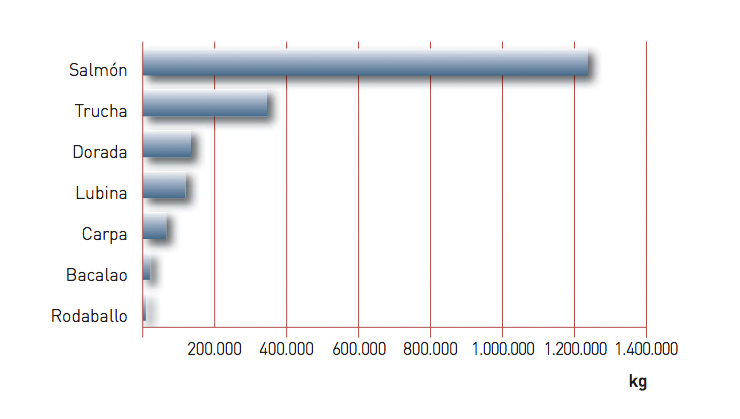
In over 25 years of mariculture, Galicia has learned to respect and farm its seas in much the same way as it grows crops and rears cattle
Medium-term projections envisage turbot productions of 15,000 tonnes a year. Provided that the necessary adjustments are made to investment costs, these figures should give no cause for alarm. Galicia’s outstanding conditions for flatfish farming -including location in a temperate part of the world and a gentle, rolling topographymean the region has a key role to play in this industry. It should not miss the opportunity to continue leading the sea fish farming industry.
Medium-term projections envisage turbot productions of 15,000 tonnes a year. Provided that the necessary adjustments are made to investment costs, these figures should give no cause for alarm
In over 25 years of mariculture, Galicia has learned to respect and farm its seas in much the same way as it grows crops and rears cattle. Though some may strive to portray it as different from agriculture and animal breeding, the truth is that fish farming is more than 4,000 years old and must be viewed as a food industry, duly respecting social and environmental standards. Only time will prove us right.
Competitive analysis of Galician sea farming
Strengths
- Galicia has more than 1,100 km of coastline and plentiful, unpolluted water bodies.
- A strong fishing tradition and high consumption of sea products.
- Good sea product marketing channels.
- Galicia has a recognised brand image for quality.
- Galicia is Europe's leader in the production and marketing of mussels, the world leader in the production and marketing of turbot and the largest producer of sea bream and trout in Spain.
- Extensive scientific research support with a specialist, cutting-edge aquaculture training centre.
- Government support for R&D&i.
Opportunities
- Special oceanographic and topographic characteristics for sea farming (temperature, salinity, pH, bacteriology).
- Strong potential for new marine species. Farming for restocking purposes possible.
- Increased production needed to meet global demand.
- Continuously expanding industry. Food source.
- Logistic and business potential in sea products trade.
- Map of coastline use favours aquaculture.
- A source of employment in scantily populated coastal areas.
- The establishment of a Galician Aquaculture Technology Cluster.
- Investment in improving production technologies.
Weaknesses
- Sea industries growing below their potential.
- Atomisation and dual structure (small and large growers).
- Diseases.
- Complex, adverse government framework and highly restrictive legislation on coast use.
- Shortcomings in the real stance of public agencies supporting aquaculture and in the implementation of the Strategic Plan on Aquaculture.
Threats
- Strong increase of pressure from environmentalist groups.
- Tighter environmental requirements.
- Competition with aquaculture products from other countries.
- Higher prices of raw materials used in feed production.
1 APROMAR: Asociación Empresarial de Productores de Cultivos Marinos de España Association of Spanish Sea Farming companies (www.apromar.es)
2 Instituto Español de Oceanografía. Spanish Institute of Oceanography
References
APROMAR (Association of Spanish Sea Farming Companies): La Acuicultura Marina en España, 2012.www.apromar.es
Bautista, Carmen: Peces marinos. Tecnología de cultivo, Mundi Prensa, Madrid, 1991.
Vigo Oceanography Centreo www.vi.ieo.es
CETGA (Galician Aquaculture Technology Centre, Galician Aquaculture Cluster) http://www.cetga.org
FEAP statistics 2012
FAO www.fao.org
Fernández Casal, J. y J.L. Rodríguez: Evolución del cultivo del rodaballo (Scophthalmus maximus) en los últimos 10 años (1998-2007). X Foro dos Recursos Mariños e Acuicultura das Rias Galegas, Santiago de Compostela, 2008. Pags. 171-176.
Spanish Institute of Oceanography http://www.ieo.es
Pardellas, Xulio y Elisa Polanco: Acuicultura Marina en Galicia, Ed. Xerais, Vigo, 1964.
“Experience in farming turbot, Scophtalmus maximus, in floating sea cages - progress since 1970” by The British White Sea Authority. S.T. Hull & R.D. Edwards. White Fish Authority, Marine Farming Unit, Ardtoe, Acharacle, Argyll, Scotland. February 1976.
Insurance in aquaculture: an overview
Ferrán Bonet
Insurance and reinsurance broker for the agri-food industry
Barcelona - Spain
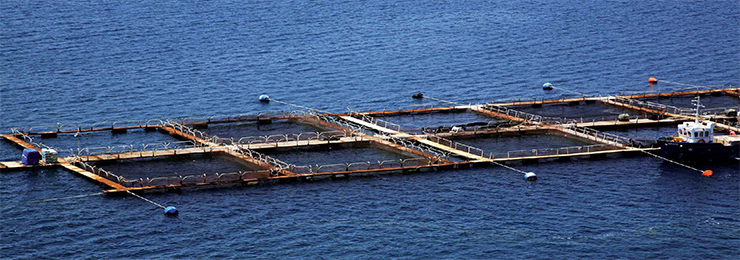
Introduction
Industrial aquaculture as we know it is a technique with barely 50 years of history, although fish farming was already known to several cultures in antiquity. Today, aquaculture enjoys unprecedented growth the world over as a result of the depletion of extractive fisheries and like any other area of economic activity, it requires insurance products that are adapted to its specific needs and particularities.
Insurance and aquaculture
Aquaculture is broadly divided into fresh -or brackish- water farming, and salt-water farming. Farms can be land-based, where the fish are grown in tanks of different shapes made with natural or artificial materials, or else offshore, with the fish in cages, rafts, baskets or long-line systems. Insurance schemes must be adapted to the environment and the rearing system, as the risks involved are different. There is little similarity between growing trout in a river-based operation and growing sea bream in offshore cages.
First, an itemised appraisal is carried out of the biomass and other assets contained in a farm, taking into account the type of facilities to be insured.
In a hatchery or a nursery, the eggs, larvae, fry and breeding specimens are valued. While the last are valued according to their species, breeding potential and age (sometimes reaching considerable values, even in excess of 1,000 euros per unit), the eggs, larvae and fry are valued on the basis of the farm’s fixed and variable costs allocation. The estimated value of farms in this category on the whole remains largely constant with time.
In growing farms, the value is determined as the cost of purchasing the fry plus the fixed and variable costs allocation in euros per kg. To calculate the insured value, which can vary widely over the course of the year, the producer submits the farm’s “breeding programme” or “production programme”, detailing the number of fish and kilos of biomass for every individual month. An examination of the 12-month breeding programme allows identifying the month of maximum value, which corresponds to the insured amount. Additionally, the mean value can be calculated as the aggregate value of all the months in the year divided by 12. The mean value serves as the basis to calculate the premium rate, which in turn allows determining the deposit premium. The deposit premium must be adjusted at the end of the insurance period based on monthly stock declarations, which indicate the real mean premium for the risk concerned.
In an offshore operation, insurance schemes provide cover against the hazards which the biomass is exposed to, i.e. storm damage, pollution, poisoning, collisions with boats and other objects, theft, malicious acts, de oxygenation due to high water temperature or benthic upwelling, and disease. On the other hand, if the farm is located on a river, as in a trout rearing facility for example, the risks covered will include pollution, floods and landslides, poisoning, drought, theft, malicious acts, electrical and mechanical failure, and disease.
As regards insurance for the facilities, the schemes must be adapted to the type of farm concerned.
In an offshore facility, all the constituent elements need to be taken into account, including nets, cages, ropes, deadmen and anchors. Insurance schemes commonly cover damage caused by storms and collisions with boats and other seaborne elements. An offshore farm will also include onshore offices and storage buildings for materials and stock. Some may also have net cleaning machines. And, being sea-based operations, they will also have specially adapted watercraft.
In a land-based facility, the insurables span civil construction elements, equipment, machinery and ancillaries. Schemes commonly cover damage by fire, explosion, lightning, miscellaneous risks and theft.
Liability is another significant area. All the activities covered need to be clearly defined in the policy. Products offering minimal protection may cover civil liability, employer’s liability and product liability.
Personal insurance plays a major role in the aquaculture business, as fish farms require a sufficiently large workforce to operate. Depending on the type of facility, a large proportion of the employees may be qualified specialists, including biologists, vets, boatmasters and seamen, divers and feeders. Under Spanish law, all employees must have accident and life insurance.
Other forms of insurance are also needed, such as transport, vehicle, and industrial schemes for processing and packaging plants. There is a vast array of possibilities, all of which must be properly analysed and understood in order to cater for them competently and professionally.



